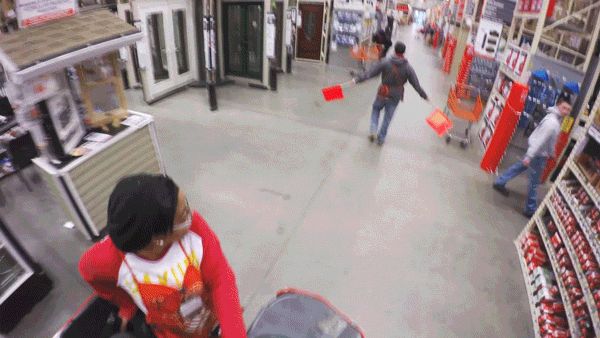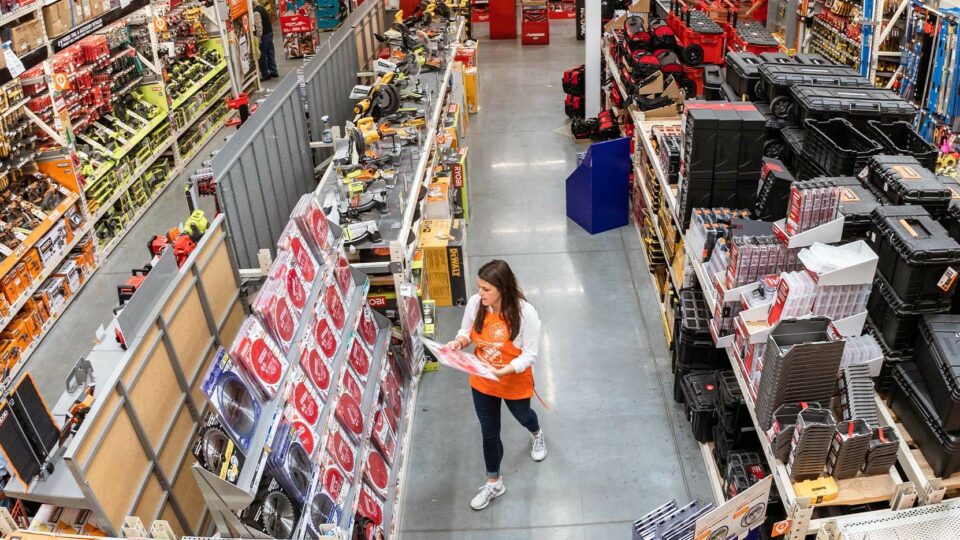
Editor’s Note: As the Retail Innovation Conference & Expo (RICE) nears, we’re highlighting recent coverage of some of the speakers and companies that will be taking the stage in Chicago, June 4-6, 2024. Zach Darkow, Head of Marketing Measurement at the Home Depot, will join a dynamic discussion with Jeffrey Bustos of IAB, Claire Wyatt of Albertsons Media Collective, and Parbinder Dhariwal of CVS Media Exchange, to discuss how the retail media landscape is evolving to create more immersive, and measurable, shoppable moments. Register now to sit in on this and other high-value sessions featuring executives from Amazon, Babylist, Bubble, Ikea, Rebecca Minkoff, and many more. For more details on this year’s event, check out the official Retail Innovation Conference & Expo hub.
Home Depot is the self-proclaimed home of “the doers.” And that mentality of empowering people’s entrepreneurial drive extends inside the organization as well, where Home Depot has built a robust retail media operation that began long before “retail media” was a commonplace term.
It started in 2018 when pioneering marketing executive Melanie Babcock saw an opportunity to let the Home Depot’s suppliers bid for retargeting traffic. At the same time, another group in the company wanted to begin offering advertising on The Home Depot website, “so we came together, because it would have been silly to develop two separate ad programs,” Babcock explained in an interview with Retail TouchPoints.
“As a result, our media offering grew on-site and off-site at the same time. It wasn’t by any great strategic forethought; it was more just the nature of our business, but I’m so happy it happened that way,” she said. “I think a lot of retail media networks focused first on their on-site business and now they are thinking about off-site, but off-site is a very, very different ballgame. We were challenged from the beginning to think about how to build both together.”

She brushes it off as happenstance, but the fact is that throughout her career, Babcock has managed to be at the forefront of some of the biggest advancements in marketing and advertising. She got her start at a web development agency in the early days of the internet, helping brands build websites and buy keywords (that very first of digital marketing tactics). Eventually, she moved to a larger firm where Home Depot became her client. Then she moved to a PR firm where she focused on social media because she believed it would be “the next wave of the internet,” and Home Depot became her client once again.
For five years she helped Home Depot explore the burgeoning realm of social media, until the retailer convinced her to come run its internal social media practice in 2013. In her 10 years at Home Depot, Babcock’s role has continued to expand, most recently with her promotion earlier this year to VP of Retail Media+ and Monetization, where she now leads the retail media network she helped to create.
Today, Home Depot’s Retail Media+ offering includes a range of ad products across its website, mobile app, emails and more, as well as off-site partnerships with Meta, Google, Pinterest, Yahoo and The Trade Desk.
To learn more about retail media, check out our full guide here.
Babcock sat down with Retail TouchPoints to talk about where she’s looking next and how the idiosyncrasies of Home Depot’s customers and stores have helped define its differentiators amid a “sea of retail media networks.”
Retail TouchPoints: How have you managed to always be at the bleeding edge of what’s happening in digital advertising?
Melanie Babcock: Whenever someone asks what I do, I say “If there’s a gray space or an ugly space that has no structure, throw me in.” I like to create something out of nothing, and I still get that opportunity today. To be honest, when I first joined Home Depot I was worried I wasn’t going to be able to be creative, but boy was I wrong. Because Home Depot is so centered on the entrepreneurial spirit, I’ve been able to lean heavily into that skill.
The thing I’ve learned most at Home Depot is how to drive true business value out of marketing. Marketing is measured by incremental dollars — you see sales impact or you see customer impact. But we had to create the structure just to even measure that way so we could go to our CEO with confidence and say, “The dollars you’re investing in marketing are driving incremental sales and customer return.” All those things that we love to talk about as marketers, we’ve had to really measure them here, and I’m grateful for that rigor, because it’s really pushed us from a technology and a data perspective and even in our thinking.
That’s been a big part of my journey throughout my career, but mainly at Home Depot — how rigorous [we as marketers have to be] about the value we’re producing. And that parlays easily into retail media. Our suppliers are already dedicated to Home Depot, but we need to prove the value so that when they put a dollar into Home Depot versus another media channel, they see the return and the value they’re getting back. That value is sales; that’s the number-one KPI. But they’re also learning other things about their customer or their product. There’s a lot of information that we bring that is of high value to our suppliers, that wasn’t accessible without retail media.
RTP: So how are you driving this incremental value for your suppliers?
Babcock: Well first, I don’t think we have a common definition of incrementality. Value isn’t just incremental sales, it’s many other things. I see retail media as the last-mile delivery of the media world. When you look at how you get products from your warehouses to your stores and your customers, that last mile is the hardest and most expensive mile in a supply chain. And I liken it to retail media. Before retail media, the supplier had access to all kinds of media channels, but they never knew, in that last mile, did the customer convert because of that campaign? Only the retailer knew where they converted; suppliers couldn’t see beyond that last click. They called it a success because they drove the customer to a retailer, but they never knew if that customer actually converted.
Retail media is now bringing last-mile media to those suppliers so they can see the full picture, whether it’s a brand campaign or a consideration campaign or a performance/conversion campaign. And remember, a brand campaign isn’t all about sales. It’s about driving preference or even just awareness, but at least Home Depot can show you closed-loop attribution on how that customer behaved with that ad — whether it’s on HomeDepot.com or external. That to me is the value.
As for incremental sales, I think we’re still struggling with that as an industry. When I think of incrementality at a mass retailer like grocery it’s: “Did they buy me instead of my competitor this week?” But at Home Depot, we have our own definition of incrementality because customers don’t shop like that. They come to our store eight to 12 times a year. If I asked you when the last time was that you painted a room, likely your answer is five to seven years ago. So, if you come into Home Depot and buy a can of paint, is that an incremental sale? No. The customer isn’t changing their [purchasing choice as a result of marketing]. For us, it’s about capturing the customer in the time that they need us.
That said, we’re really rolling around on this one, because we know there’s [something like] 56 retail media networks now, of which 30+ were born in the last 18 months. That’s a lot of competition, a lot of saturation. We will need standardization around what these things mean, and incrementality is one of them. We are looking at how to efficiently measure incremental sales and scale it. I can do it one-off. Any supplier can ask me, and we can run an algorithm for that. But how do we scale that so it’s systematic across all our thousands of suppliers? That’s the piece that we’re working on.
RTP: Given how different your customers’ shopping behaviors are from those of other retailers, do you see other retail media networks as competitors, or do you feel like you’re playing on a different field?
Babcock: There are standard expectations by suppliers. Years ago when I was at the web development agency and people wanted an internal search engine, they would say, “Make it like Google.” Google became that standard and set the expectation of how a search engine should operate. I think retail media networks have similar pressures, whether a supplier is in a grocery store or not.
Most suppliers are super smart and very strategic when it comes to retail media investments, and they challenge us to be more like the mass, because the mass retailers may be further ahead of us maybe in a measurement type or a feature. I don’t think that I’m necessarily competing with someone like Kroger, but I do think [RMNs like] Kroger are setting a standard in the market that all retail media networks need to consider. That’s why we keep a close eye on other retail media networks to see which of those standards or expectations we want to lean into and include in our own roadmap.
RTP: Much of the conversation around retail media this year has centered on bringing it into stores. Where do you stand in that regard?
Babcock: We do have an in-store network — it will be in 100 stores soon. But right now for us it’s about testing and learning. Our stores, like any other retailer, are where the majority of our traffic is, so it’s something you can’t ignore as a retail media network. We also have a high proportion of customers that start their journey online and finish in store, so we absolutely need to bring that [media] experience all the way through to the cash register.

But the thing about our stores is they are working warehouses. At any given moment, there’s a forklift driving by or there’s sawdust [flying through the air], so our in-store network has to be tough enough to survive in that environment. Our store structure is also different. We’re similar to a Sam’s or a Costco where our bays go from floor to ceiling. Mass retailers that don’t have that floor-to-ceiling [shelving] have a different opportunity of where to put their video screens, but I have to figure out how to get screens into these bays without them getting smashed by forklifts or shopping carts or some heavy item.
We’ve been testing and learning how to successfully deliver screens into our stores while adhering to the unique rules of our store environment, and I think we’ve cracked the code on it, so now we’re going to start releasing more and more screens to the store.
RTP: What do you see ahead for retail media in the coming years?
Babcock: Every retail media network grew up saying performance, performance, performance, because at the end of the day, if you’re not providing good conversion, then people are going to take their money elsewhere. That’s expected. At Home Depot, we spent this summer really thinking about how we can differentiate ourselves in a sea of these retail media networks, and [we decided to] lean into our brand ethos of service.
It’s about thinking and becoming more like an agency and helping suppliers be successful in our environment from top to bottom. It’s not just about logging in and buying an ad unit and making it all automated — it’s about providing help along the way. That’s an expensive statement because it requires technology and people, but our brand has always been about helping, so I feel like that is an area we can lean into. It’s not just about conversion. It’s thinking about how to help them stand out. How do they learn about the customer? How do they know where to go next for their business?
When I think about the future of retail media, I think the way to differentiate is through these audiences. We can all offer the same ad units and we can all say that we’ve got the best traffic, but really leveraging our stores and really leveraging what we know about the customer will continue to differentiate us and I think others too. Suppliers are going to place their bets, so how do we make sure their expectations are met, but then also layer in an understanding of who our customer is and how our supplier best fits?
Your supplier has already picked you. Before your retail media network, they saw success with you, so how do you help them grow further with the ad products and the service and the people, so they grow with you?
Register now for the Retail Innovation Conference & Expo to hear directly from some of the industry’s most innovative thinkers and brand leaders on topics like retail media, CTV, community-driven commerce experiences, digital community building, and more. Join us to get the inside scoop from brands like Michaels, Bubble Skincare, Primark, Macy’s, and many more!















